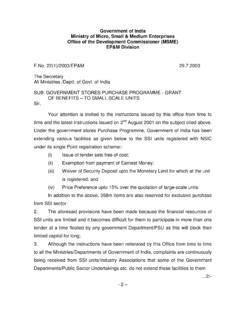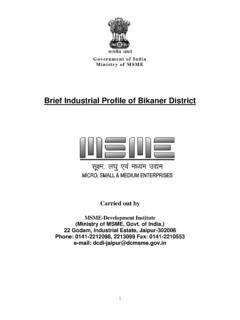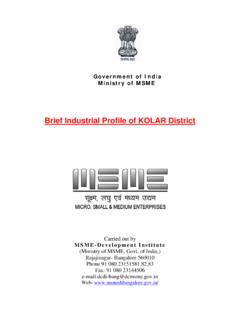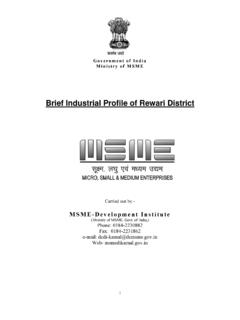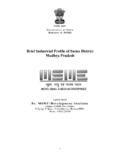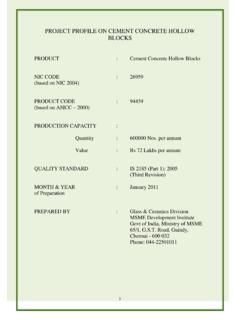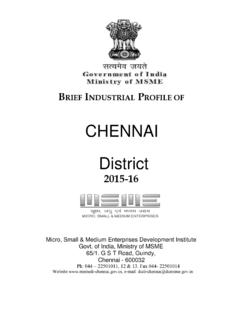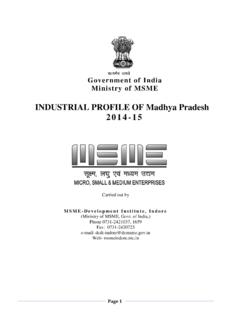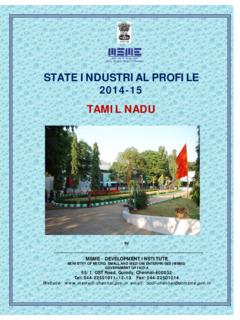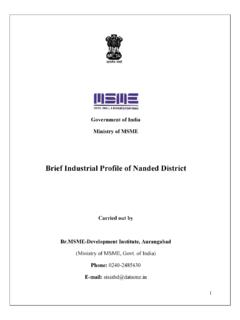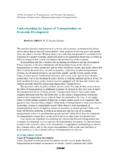Transcription of Contents
1 Contents S. Topic Page No. No. 1. General Characteristics of the District 5. Location & Geographical Area 5. Topography 6-7. Availability of Minerals. 8. Forest 9. Administrative set up 9. 2. District at a glance 9-11. Existing Status of Industrial Area in the Amravati District 12. 3. Industrial Scenario Of Amravati District 12. Industry at a Glance 12. Year Wise Trend Of Units Registered 13-14. Details Of Existing Micro & Small Enterprises & Artisan Units In 14-17. The District Large Scale Industries / Public Sector undertakings 18-20. Major Exportable Item 20. Growth Trend 20-22. Vendorisation / Ancillarisation of the Industry 23. Medium Scale Enterprises 23-27. List of the units in Amravati & nearby Area 27. Major Exportable Item 27. Service Enterprises 27. Potentials areas for service industry 27. Potential for new MSMEs 28. 2. 4. Existing Clusters of Micro & Small Enterprise 28-29. 5. General issues raised by industry association during the course of 31.
2 Meeting 6 Steps to set up MSMEs 32. 3. 4. Brief Industrial Profile of Amravati District 1. General Characteristics of the District: For the purpose of administrative conveyance, the district is divided into 14 Tahsils and 14 Panchayat Samities. According to the 2001 C ensus, there was 843 Gram Panchayat for the purpose of Rural Development. Amravati district stretches over an area of 12212 Sq. Km. In the terms of area; Amravati district constitutes of the total area of the Maharashtra State. Total population of the district according to 2001 census was 2607160 out of which 1345610 were males and 1261550. were females. Of the total population, is residing in rural area and is residing in urban area. The density of the population according to the 2001 census was 214 persons/Sq. Km. Location & Geographical Area: The total geographical area of Amravati District is 12212 sq. km. and its only % of Maharashtra. 75% of Amravati district covered by Deccan Trap while 25% area covered by Purna alluvium.
3 The global location of the district extends between ' to ' north latitude and ' to ' east longitude. Amravati district is located in the Vidharbha region on the north eastern side of the State of Maharashtra. It is bounded by the Khandwa and Betul districts of Madhya Pradesh State on the north and by the Maharashtra districts of Nagpur on t he northeast, Wardha on t he east, Yavatmal on the south, Washim on the southwest and Akola and Buldhana districts on the west. Connectivity: Railway The Mumbai-Bhusaval-Nagpur-Kolkata broad gauge rail line, Murtijapur-Achalpur, Khandwa- Akola-Purna and Badnera-Amravati meter gauge rail line run through the district. These connect Amravati to the bigger cities of Mumbai, Jalgaon, Nagpur, Delhi and Chennai. Roadways The National Highway 6 that runs between Hazira-Dhule-Kolkata passes through the district, thus making markets accessible and helping trade and business in the district. 5. Topography: The total geographical area of Amravati District is 12212 sq.
4 Its only % of Maharashtras. 75% of Amravati district covered by Deccan Trap while 25% area covered by Purna alluvium. The total area of Purna alluvium is 3053 out of which 1562 area belongs to saline zone which is Quality affected area. The ground water in this area is not used for Irrigation and Drinking water purposes, where as North East part of district there is high irrigation activity mainly orange fruit crop which develop imbalance in ground water. Geography: The district's rich natural resources feature hills and vales and dense forests on t he Satpura range. Centred in the Vidharbha region, the district has mostly tropical climate, facing extreme variations in temperature with very hot summers and very cold winters. Summer temperatures can go up to the higher 40's. Amravati district receives rainfall from south westerly monsoons mainly in the months of June, July, August and September. Chikhaldara and Dharni talukas form the Melghat region that is spread over 4000 sq km.
5 This region boasts of thick forests spread over the Satpura mountain range. The forest in Dharni has predominantly teak while that in Chikhaldara has bamboo. Tendu leaves can also be found here in plenty. The taluka headquarters of Chikhaldara is a famous hill station that maintains a cool temperature even in the hot summers. The taluka of Chandur-Railway next to the city of Amravati, at a height of 500m above mean sea level, is also a hilly region. The rest of the district is mainly a plateau with fertile black soil. The Purna and Wardha River beds are rich and fertile. Large rivers like Purna, Wardha, Tapi, Sipna and smaller rivers like Kapra, Gadga, Chudaman and Kholat flow through the district. Wardha River marks the eastern boundary of the district and the Tapi River its northern boundary. The Shahanur dam, built on the Shahanur River is situated in the Anjangaon-Surji taluka while the Chandrabhaga dam on R iver Chandrabhaga is situated in the Achalpur taluka near Bopapur.
6 What is noteworthy: Chikhaldara hill station, Melghat Tiger Reserve, Gurukunj Ashram at Mozari . Amravati district is steeped in mythology and fables with references in the great Hindu epic Mahabharat. Rukmini, Lord Krishna's wife, is believed to be the daughter of the king of Kundinpur (currently known as Kaundinyapur). It is said that Lord Krishna kidnapped Rukmini while she was praying at the temple of Amba Devi. 6. Demography: Geographical area (sq km) 12,210. Population 2,607,160. Rural 1,707,581. Urban 899,579. Male 1,345,614. Female 1,261,546. Sex ratio (M:F) 1000:938. Literacy (%) Male literacy (%) Female literacy (%) Agriculture Like the rest of Vidharbha, the economy in Amravati is mainly dependent on agriculture. Food grains occupy the largest cultivable area, out of which, Sorghum occupies nearly 50%. It is also the main crop of the district occupying 20% of the irrigated land area and is mainly cultivated in the Tivsa, Nandgaon-Kandeshwar, Morshi, Warud and Chandur-Railway talukas.
7 Cotton is an important cash crop in the district as a large part of the planes has black soil suitable for cotton, known as Regur soil or black cotton soil. The district is always among the first three districts in the State in terms of total cultivated area and production of cotton. Red gram, wheat, green chickpea, sugarcane, green chillies, oranges, sweet lime and betel leaves are the other crops grown in the district. Amravati district is also famous for oranges and along with Nagpur, tops the production of oranges in the State. Rainfall and Temperature The climate of this district is hot and dry. The year is divided into three seasons, cold season is from November to February, hot season is from March to May and the monsoon season is from June to October. The area receives rainfall during southwest monsoon. The average rainfall 700-800 The maximum temperature during summer goes upto 460c while the minimum temperature during winter drops to 50- 90 c.
8 River and Drainage pattern There are three main river Tapi, Purna and Wardha .The Purna rises in the southern slopes of Gavilgarh hills and flows southunly &S-E direction till it tu rns Westward and from a part of the district boundary between Amravati & ,Arna, Chandrabhaga and the Shahnur are imp ortant tributaries of Wardha river rises at Multai in Madhya pradesh and from the eastern boundary of district and receives a number of short tributaries at its right flowing within district Maru And Chargar are important tributaries that join Wardha. The Tapi flows along the N-W boundary of the district Khardu, Sipna, Dewal & Dhulghat are its tributaries. Mainly area shows dendrites drainage pattern, while Purna alluvium basin cover parallel to sub parallel drainage pattern & is almost plain area. 7. Availability of Minerals: Amravati district is one of the few locations in the State having Sandstone. The only Major mineral found in district is Fireclay. It is found in Achalpur Tahasil.
9 Any construction material is categorized into minor mineral Murum, Stone, Sand, clay. PRODUCTION OF MINERAL 2010-11. NAME OF MINERAL PRODUCTION in Lakh tones 2010-2011. MAJOR MINERAL. 1. Fire clay 5323. (11034 during 2011-12). 2. MINOR MINERAL PRODUCTION in MT. 2010-2011. 1. Sand 1203488. 2. Clay,bricks 471200. 3. Stone/bolder 3900000. 4. Gitti 560000. 5. Murum 240000. Source: - District mining officer, Amravati 8. FOREST. The forests in Dharni and Chikhaldara talukas have bamboo and teak trees in plenty. Chikhaldara also grows coffee and is the only region to have coffee plantations in the entire State. Administrative set up. The district of Amravati consists of 14 t ehsils, namely, Daryapur, Anjangaon-Surji, Achalpur, Chandur Bazaar, Morshi, Warud, Tivsa, Bhatkuli, Amravati, Nandgaon- Kandeshwar, Chandur-Railway, Chikhaldara, Dharni, Dhamangaon-Railway; While 10. Municipal corporations. The Amravati is the districts headquarter. 2. District at a glance Particular Year Unit Statistics 1 Geographical features (A) Geographical Data i) Latitude to ii) Longitude to iii) Geographical Area Sq.
10 KM 12210. (B) Administrative Units i) Sub divisions NA. ii) Tehsils 2011 14. iii) Villages 2002. iv) Patwar Circle NA. v) Panchayat Simitis 14. vi)Nagar Nigam 1. vii) Nagar Parishad 10. viii) Gram Panchayats 843. xi) Revenue villages 2002. x) Assembly Area 8. 2. (A) Sex-wise i) Male 2001 Thousand 1345610. ii) Female 2001 Thousand 1261550. (B) Rural Population 2001 Thousand 1707580. 3. 9. A. Land utilization i) Total Area 2007-08 TH. Hectare 1168. ii) Forest cover 2007-08 321. iii) Non Agriculture Land 2007-08 14. v) cultivable Barren land 2007-08 26. 4. (i) Forest 2010-11 TH. Hectare 321. 5. A. Cattle i) Cows 2007 Thousand 506. ii) Buffaloes 2007 Thousand 123. B. Other livestock i) Goats 2007 Thousand 368. ii) Pigs 2007 Nos. NA. iii) Chicken & Duck 2007 Thousand NA. iv) Railways i) Length of rail line 2010-11 Kms 195. V) Roads (a) National Highway 2010-11 Kms 57. (b) State Highway 2010-11 Kms 1448. (c) Main District Highway 2010-11 Kms 1343. (d) Other District Roads 2010-11 Kms 1202.
